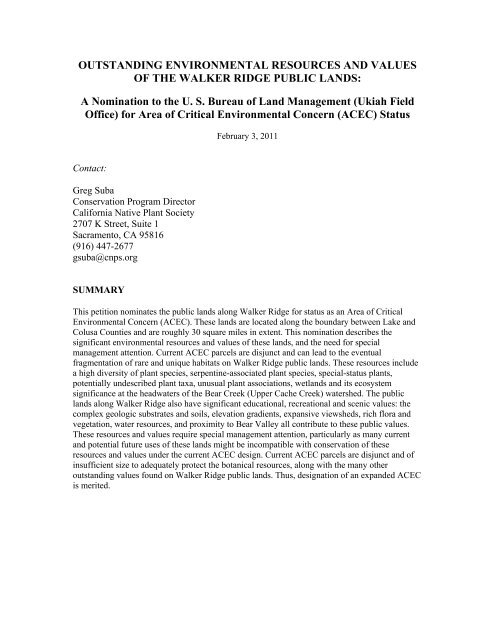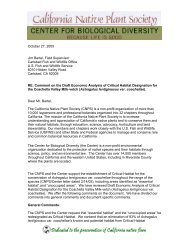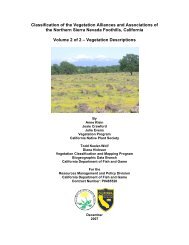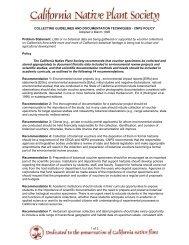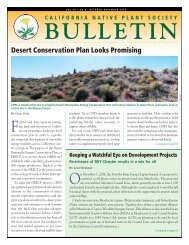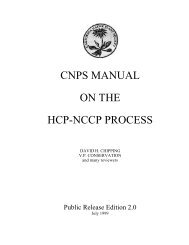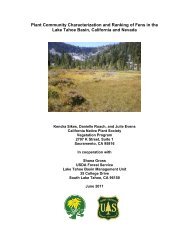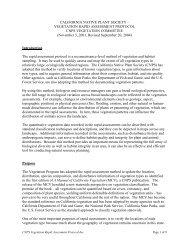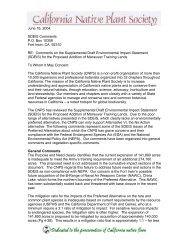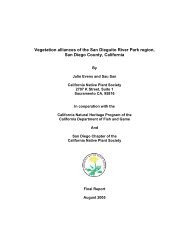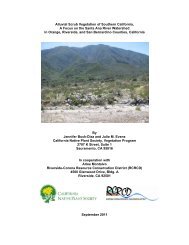Petition - California Native Plant Society
Petition - California Native Plant Society
Petition - California Native Plant Society
You also want an ePaper? Increase the reach of your titles
YUMPU automatically turns print PDFs into web optimized ePapers that Google loves.
In 2006, three ACEC parcels were established over greatly disjunct areas of Walker Ridge publiclands to protect serpentine ecosystems and associated sensitive plant species. Yet many of thesame values represented in the current disjunct ACEC parcels extend over the entire Walker Ridgepublic lands. The geographical extent and biological sensitivity of these serpentine ecosystemssupport the need to protect the remaining critical values on Walker Ridge public lands throughspecial management designation of a landscape-level ACEC. Moreover, many significant areasexist outside of the designated ACEC parcels that also warrant greater protection andmanagement. Expansion of the existing ACEC-designated lands into a larger contiguous ACECwill ensure that all of the Walker Ridge ecosystem values will be protected. This will aid inproactive, ecosystem-level management of key habitats, and the long-term maintenance of viablepopulations of serpentine endemic species.The Walker Ridge public lands represent a critical focal area for conserving endemic native planttaxa, important wildlife habitats, and regional migration corridors. To protect and enhance theseat-risk lands, the expansion of the existing Walker Ridge ACEC areas into an ecologicallyappropriate size and design is both needed and warranted.III. UNIQUE ENVIRONMENTAL RESOURCES AND VALUES OF WALKERRIDGEThis section describes the significant environmental resources of Walker Ridge and their societalvalues. The significant environmental resources of the Walker Ridge lands include intact habitatfor a high diversity of vascular plants, numerous serpentine-associated plant species, specialstatusplant species, potentially undescribed plant species, unusual plant associations, wetlands,and low degree of invasive, non-native species. Additionally, the Walker Ridge public landsrepresent a significant portion of the headwater lands and tributaries of the Bear Creek (UpperCache Creek) watershed, a 65,000-acre landscape that has been the focus of large-scale federal,state and private conservation efforts. In addition to the outstanding ecological values found onWalker Ridge, there are also significant educational, recreational, and scenic values.Outstanding Environmental ResourcesThe Walker Ridge lands represent a substantial component of the watershed from which waterand materials enter Bear Valley. Walker Ridge provides a significant ecosystem connection fornumerous plant and animal populations that extend across both Walker Ridge and Bear Valley.Walker Ridge is adjacent to Bear Valley, a renowned wildflower area, where a large public andprivate investment of $1,500,000 was made to purchase a conservation easement there to protectthe scenic, conservation, and working landscape values in perpetuity. In addition, the WalkerRidge area is located within the Berryessa Snow Mountain region. Conservation groups, localcommunities, and legislators have come together to support designating the Berryessa SnowMountain region as a National Conservation Area for future generations to enjoy. Furthermore, aDepartment of Interior memo entitled “Prospective Conservation Designation: NationalMonument Designations under the Antiquities Act” lists the Berryessa Snow Mountain region asone of the “nationally significant landscapes . . . worthy of inclusion in the NLCS (NationalLandscape Conservation System).” The memo states that the areas listed “may be goodcandidates for National Monument designation under the Antiquities Act.”The habitats of Walker Ridge provide undisturbed wildlife corridors, allowing connectivity fromthe Klamath Region and Mendocino National Forest, to the north, through the Cache Creek5
and worldwide significance. Serpentine soils are known throughout the world as hotspots forplant evolution. Together with Turkey, Cuba and New Caledonia, <strong>California</strong> is one of the fourrichest places in the world for serpentine endemic plants (Brooks 1987). Within <strong>California</strong>, therichness of serpentine endemics reaches its peak in the North Coast Ranges (Kruckeberg 1984,Harrison et al. 2000). Of the 215 serpentine endemic plants in the state, 58 are found in LakeCounty alone, compared with 36 in the entire South Coast Ranges and 16 in the entire SierraNevada (Kruckeberg 1984, McCarten 1988).Special-Status <strong>Plant</strong>sAmong the uncommon and rare plants occurring along Walker Ridge and surrounding lands,several are BLM special-status species (CNDDB, November, 2010). Special-status speciesreported at Walker Ridge include the following <strong>California</strong> State Rare, State Endangered,<strong>California</strong> Rare <strong>Plant</strong> Rank (CRPR) 1B 1 , and CRPR 4 2 taxa:Amsinckia lunaris (bent-flowered fiddleneck) (CA Endangered, CRPR 1B)Arctostaphylos canescens ssp. sonomensis (Sonoma canescent Manzanita) (CA Endangered,CRPR 1B)Astragalus rattanii var. jepsonianus (Jepson’s milk-vetch) (CRPR 1B)Atriplex joaquiniana (San Joaquin spearscale) (CRPR 1B)Balsamorhiza macrolepis var. macrolepis (big-scale balsam root)(CRPR 1B)Brodiaea coronaria ssp. rosea (Indian Valley brodiaea) (CA Endangered, CRPR 1B)Calystegia collina ssp. tridactylosa (three-fingered morning glory) (CA Endangered, CRPR 1B)Castilleja rubicundula ssp. rubicundula (pink creamsacs) (CRPR 1B)Eriastrum tracyi (Tracy's eriastrum) (CA Rare, CRPR 1B)Eriogonum nervulosum (Snow Mountain buckwheat) (CRPR 1B)Fritillaria pluriflora (adobe-lily) (CRPR 1B)Harmonia hallii (Hall’s harmonia) (CRPR1B)Hesperolinon drymarioides (drymaria-like western flax) (CRPR 1B)Layia septentrionalis (Colusa layia) (CRPR 1B)Monardella villosa ssp. globosa (robust coyote mint) (CRPR 1B).Streptanthus morrisonii (Morrison’s jewel flower) (CRPR 1B)Other BLM special-status plant species may be present at Walker Ridge. Additional plant speciesof concern reported on Walker Ridge include:Astragalus clevelandii (CRPR 4)Asclepias solanoana (CRPR 4)Delphinium uliginosum (CRPR 4)Collomia diversifolia (CRPR 4)Calystegia collina ssp.oxyphylla (CRPR 4)1 CRPR 1B plants (formerly known as CNPS List 1B) are rare throughout their range with the majority ofthem endemic to <strong>California</strong>. Most CRPR 1B taxa have declined significantly over the last century. 1Bplants are considered rare, threatened or endangered in CA and elsewhere.2 CRPR 4 plants (formerly CNPS List 4) are of limited distribution or infrequent throughout a broader areain <strong>California</strong>. While they occur more commonly from a statewide perspective, they are of limiteddistribution, and uncommon enough that their status should be monitored regularly for changes to thedegree of endangerment or rarity.8
Senecio clevelandii (CRPR 4)Clarkia gracilis ssp. tracyi (CRPR 4)Navarretia jepsonii (CRPR 4)Collinsia greenei (CRPR 4)Lomatium hooveri (CRPR 4)Astragalus breweri (CRPR 4)Other plant species of concern may be present at Walker Ridge. Incompatible management ofWalker Ridge would contribute to further declines of these species, and increase their likelihoodof federal or state listing as threatened or endangered.Potentially Undescribed <strong>Plant</strong> TaxaSerpentine areas, like those along Walker Ridge, are important reservoirs of plant diversity, andtheir endemic flora has not been fully described. In <strong>California</strong>, new serpentine-associated vascularplants are still being described. Recent examples include Carex serpentinicola, Harmoniaguggolziorum and Silene serpentinicola (Zika et al. 1998; Baldwin 2001; Nelson and Nelson2004).Along Walker Ridge, several plants deserve a closer examination by botanists to clarify theiridentity, and to determine if they could be undescribed taxa. For example, on Walker Ridge thereare plants in the genera Linanthus and Streptanthus that do not key to or clearly fit thedescriptions of the described taxa in those genera.Unusual <strong>Plant</strong> AssociationsThe vegetation of Walker Ridge is extremely varied, and includes outstanding examples ofdistinctive plant associations. For example, one of the world’s largest stands of McNab Cypress(Hesperocyparis macnabiana) occurs on Walker Ridge. Additionally, large stands of Sargent’scypress (Hesperocyparis sargentii) exist there along with assemblages of knobcone pine (Pinusattenuata) and three other conifer species; grey pine (Pinus sabiniana), <strong>California</strong> nutmeg(Torreya californica), and western juniper (Juniperus occidentalis). Five different oaks (andsome unusual hybrids of those species) have been documented. Extensive stands of serpentine,non-serpentine and chamise-domimated chaparral cover much of Walker Ridge, supporting over40 species of trees and shrubs and hundreds of non-woody species. Post-fire inventories after the2008 Walker Fire revealed an extraordinarily rich array of wildflowers and other herbaceousplants. Wetland communities are abundant, supporting diverse assemblages of associated species.Although botanists have reported the presence of these and numerous other associations onWalker Ridge, its plant associations have not been formally described or inventoried. Suchresearch would be worthwhile for the management of these lands.WetlandsWalker Ridge is unusually rich in wetland habitats, including seeps, springs, riparian areas andwet meadows. These communities are critical to wildlife, harbor unique assemblages of plants,and play a key role in watershed function.Harrison (2000) documented the value of serpentine wet areas at Knoxville, noting that they hosta diverse array of late-flowering species, 25 of which are restricted to this habitat. Many of these9
plants exist on Walker Ridge, although comprehensive inventories are still needed to furtherdocument the wetland flora on the Ridge.Worldwide, natural springs exhibit a unique combination of physical and chemical properties thatgive rise to distinctive biological communities (Sada, et al. 2001), often supporting plants andanimals found nowhere else. A diversity of fresh water, alkaline, and geothermal springs arefound on Walker Ridge. The named springs found on Walker Ridge public lands are ComplexionSpring, Barrel Spring, Cold Spring, Til Jones Spring, Deadshot Spring, and Eaton Springs. Inaddition, many other (unnamed) springs exist within the proposed ACEC, which also contributesto the overall ecological and recreational values of the Walker Ridge landscape.Perennial creeks and their associated riparian communities include Kilpepper Creek, Trout Creek,and the extensive Sulphur Creek headwater drainages (Eaton Springs - East Fork tributary, TillJones Freshwater Branch tributary, West and Salt Branch Fork tributaries). Intermittent andephemeral drainages bisect much of Walker Ridge, all of which provide a great variety of waterderivedlandscape features, and critical watershed and habitat values.Numerous wet meadows occur on Walker Ridge, including the extensive Eaton Springs complexwith its hydric soils and associated riparian community. Methany Flat also supports serpentinewetland meadow and riparian species, surrounded by mixed serpentine chaparral. The BLMpicnic area at Cold Spring is another spectacular example of a unique wet meadow assemblageOne striking feature of the Cold Spring assemblage is the prevalence of the white-tomentoseswamp thistle, (Cirsium douglassii ssp. breweri). Additionally, at least nine native grass speciesoccur in the Cold Spring wet meadow area, along with many other plants that have limitedoccurrences in the region. A wet meadow two miles south of Brim Road supports the only knowpopulation of tufted hairgrass (Deschampsia caespitosa) in the Bear Creek watershed.The importance of these wetland resources cannot be overstated. While enough information isalready known that gives testament to their value, a key management objective should be a fulldocumentation of all the wetland sites that occur on Walker Ridge public lands (Weigand andThomsen 2010).Outstanding Environmental ValuesEducational ValueThe combination of its diverse flora, road access, and geographic location relative to cities in boththe Sacramento and Bay areas, has made Walker Ridge a frequent field trip destination forenvironmental education. Several universities (e.g., Humboldt State University, University of<strong>California</strong> at Davis), botanical groups (e.g., Davis Botanical <strong>Society</strong>, <strong>California</strong> <strong>Native</strong> <strong>Plant</strong><strong>Society</strong>) and others sponsor or lead trips to Walker Ridge for environmental education. AppendixA contains examples of plant lists compiled by these visits over the past several years. <strong>Plant</strong>collectors also have regularly visited Walker Ridge to collect materials for educational events anduniversity courses.In June 2008, a large wildfire burned 14,500 acres on Walker Ridge, creating a uniqueopportunity to better document the flora. Unburned for many decades, areas that were formerlydominated by dense chaparral are now accessible. Moreover, there is a rich “fire-follower” floraon serpentine and non-serpentine substrates that can now be documented. Although partial plantlists are available for Walker Ridge that demonstrate its regional and statewide significance, there10
have been no systematic attempts to document the flora, map the many rare plants and high-valueplant associations, or to describe the site-specific issues that threaten its botanical resources.The need to better document the rare and endemic flora of <strong>California</strong> for future climate changemonitoring efforts is paramount. There is now ample evidence that climate change is alreadyaffecting living systems (Parmisan and Yohe 2003). Scientists are predicting that narrowlydistributedendemics, such as special-status species and serpentine endemics like those occurringthroughout the Walker Ridge area, are at high risk of extinction as the <strong>California</strong> climate changesover the next century (Loarie et al. 2008; Harrison et al. 2009). Walker Ridge is home to manyserpentine- and near-serpentine endemics with limited distributions; these plants and theirassociated pollinators are vulnerable to even minor shifts in regional climate. Serpentineendemics are presumed to face extraordinarily high risks from climate change because theirnarrow edaphic niches limit their possibilities to adapt through migration (Harrison et al., 2009).As such, these landscapes are critical areas for climate change studies, yet their extremevulnerability to climate change has received insufficient attention and baseline documentation.Rather, the trend for the Walker Ridge area has been to consider the industrial development ofpublic lands where the best opportunities may exist for conserving and restoring key ecologicalvalues.Recreational and Scenic ValuesThe Walker Ridge lands provide numerous recreational opportunities for activities as varied ashiking, recreational shooting, bird watching, plant observation and off-road vehicle riding. But, itis their proximity to, and accessibility from, Bear Valley and Highway 20 that gives the WalkerRidge lands recreational and scenic values of more than local significance.Since the late 1990s, the American Land Conservancy (ALC), <strong>California</strong> Wildlife ConservationBoard, The David and Lucile Packard Foundation and the <strong>California</strong> Rangeland Trust (ALC2005) have conserved about 15,000 acres of the private lands adjacent to Walker Ridge. Theselands are a destination for visitors not only from the region but also from throughout the state andnation (Game and Lyon 1996; ALC 2005).The primary attraction is the spring wildflower bloom, which draws plant and photographyenthusiasts from throughout the state and nation. This recreational use is supported by aguidebook funded by numerous organizations (including Sunsweet Growers Inc., Sierra NevadaBrewing Company, Inc. and the Yuba-Sutter Appeal-Democrat), and numerous websites andarticles describing the valley and providing advice for visiting the region (Edwards 1993, Gameand Lyon 1996, Phillips 1998, ALC 2005, Leigh 2005). These publications and websites addressa national audience and describe Bear Valley and its surroundings as one of <strong>California</strong>’s bestwildflower displays, and even as “one of the most spectacular wildflower displays in the world”(Game & Lyon 1996).Many tourists travel along and recreate on Walker Ridge in conjunction with their visits to BearValley. Walker Ridge has recreational values that complement those of Bear Valley, andstrengthen the region as a destination for recreation. By driving along Walker Ridge, visitors canmake a loop drive from Highway 20 through Bear Valley, and then up and along Walker Ridgeback to Highway 20. Unlike Bear Valley, Walker Ridge provides opportunities for hiking andpicnicking, including visits to hot springs and abandoned mines, and spectacular views of BearValley, the Sutter Buttes, Indian Valley Reservoir, Snow Mountain and even Mt. Lassen. It alsoprovides an opportunity for visitors to view many uncommon plants and animals that do notoccur on the floor of Bear Valley. In fact, many photographs of “Bear Valley wildflowers” in11
guidebooks and articles are of plants that do not grow in Bear Valley but do grow on WalkerRidge, indicating that Bear Valley visitors also recreate on Walker Ridge and do not make adistinction between these two portions of this watershed.The visual values of the Walker Ridge lands have greater than local significance because of theirprominence in many Bear Valley views. Walker Ridge is part of the landscape beingphotographed in Bear Valley, which draws photographers from throughout the state and nationeach spring. Many of these visitors are also taking photographs on Walker Ridge as well.Incompatible management of Walker Ridge would contribute to decreased accessibility of theseunique lands for educational and recreational purposes.IV. ANALYSIS OF THE APPLICABILITY OF ACEC CRITERIARelevance and ImportanceSeveral resources or values of the Walker Ridge public lands described in this proposal arerelevant to its potential as an ACEC, because they constitute a significant environmental “value,resource, system, process or hazard.” Several of these resources or values are important becausethey have “more than local significance” and “special worth, consequence, meaning,distinctiveness, or cause for concern.”The relevance criterion is met by the existence at Walker Ridge of a distinctive flora and unusualvegetation, and because it constitutes a substantial portion of an ecologically significantwatershed. Importantly, these are landscape-scale attributes. These resources cannot be reduced toa series of dots on maps or sustainably conserved as a set of fenced locations.The importance criterion is met by demonstrating greater than local significance, and/or rarity andfragility. Resources and values that meet the importance criterion include the regional (i.e.,northern <strong>California</strong>) and statewide educational and recreational value of the Walker Ridgeecosystem, the uniqueness and fragility of its vegetation, and its ecological connections to BearValley, a major focus of State government and both national and state conservation organizations.Need for Special Management AttentionThe need for expanded management attention for a more ecologically relevant, expanded WalkerRidge ACEC is based on its conditions and trends, the relationship of its environmental values toother resources and activities, and the opportunities for its protection and restoration if it is sodesignated.Predominant present activities are hiking, ORV use, recreational shooting, environmentaleducation, bird watching and other nature observation, operation of telecommunication facilitiesand use as a travel route to Indian Valley or Bear Valley. Future uses could include moreextensive development of infrastructure and other facilities for recreational visitor use,transportation, telecommunications and wind energy.There is a need for management attention because several of the current or possible future usescould potentially conflict with each other, and may be incompatible with conserving the resourcesand values of Walker Ridge. Furthermore, conditions and trends by many observers areconsidered to be deteriorating.12
Serpentine areas, particularly wet areas and barrens, are fragile environments that recover slowlyfrom severe disturbance. This argues that Walker Ridge is not an easy place to conserveenvironmental resources in combination with its other uses. Several uses pose no substantialconflicts with conservation of environmental resources including recreational shooting, legalhunting, hiking, mountain biking, horseback riding, bird watching and nature study (these uses,however, may not all be compatible with each other). Uses that disturb vegetation and compactsoil (e.g., ORV use) at a minimum, require careful management to be compatible with usesinvolving extensive clearing of vegetation and grading. Uses that disturb vegetation andcompacting soil (e.g., development of additional infrastructure and other facilities) are probablynot compatible with conservation of the environmental resources and values of Walker Ridge.The sensitivity of Bear Valley’s visual resources also should be taken into consideration in themanagement of Walker Ridge. Installation of larger structures that are visible from Bear Valleywould impair its visual resources and elsewhere in the region, including public lands to the southsuch as the Bear Creek Ranch and the Cache Creek Wilderness.Another special management issue includes monitoring and controlling the spread of invasive,nonnative species. Barbed goatgrass (Aegilops triuncialis), one of several wildland invasiveplants on Walker Ridge, is an extremely noxious species that reduces native plant biodiversity onserpentine soils. Barbed goatgrass occurs along Brim Road leading to Bear Valley. Withoutcontrol efforts, it could easily spread on Walker Ridge—as it has elsewhere in the neighboringareas.Considerable public funds have been spent on controlling invasive plants on adjacent BLM lands(Bear Creek Ranch) south of Highway 20, the Caltrans-designated Bear Creek BotanicalManagement area along Highway 20, and at nearby Bear Valley, just east of Walker Ridge(Thomsen et al. in press). Stewardship of public lands includes maintaining the native plantcommunities upon which wildlife and people depend for a wide range of ecological services,habitat, and recreational opportunities.On Walker Ridge, non-native invasive plants can be expected to increase where grounddisturbances and human activities co-occur, and their increased presence will have a markedinfluence on the native botanical resources there. In some wetland areas, two invasive specieshave already made substantial inroads into the native plant communities; annual yellowsweetclover (Melilotus indica) at Eaton Springs and elsewhere, and compass plant (Euphorbialathyrus), at the BLM picnic area near Cold Spring.Weigand and Thomsen (2010) emphasized the need to rehabilitate OHV trails and automobiledamage in sensitive areas such as wetlands on Walker Ridge. Vehicle use reduces plant cover,causes soil compaction, and alters water flow. These disturbances also affect lower impactrecreational values and facilitate the spread of invasive plants.Many of the environmental features, human uses, and management problems found throughoutthe Walker Ridge public lands also have been present at other BLM lands and played a key rolein ACEC designation (e.g., in the Red Hills Management Area) or in requests for suchdesignation (e.g., the Knoxville public lands). Walker Ridge actually has environmental resourcesof comparable or greater uniqueness and sensitivity than other nearby ACECs and RNAs andACECs and RNAs with similar types of resources (e.g., the Northern <strong>California</strong> Chaparral RNA,and the Cedar Roughs and Cache Creek ACECs.) It also has comparable or greater environmentalvalues than these existing ACECs and RNAs.13
This nomination does not propose any specific management policies for Walker Ridge. However,it does argue that the conditions and trends of environmental resources and values on WalkerRidge meet and exceed the criterion of “need for special management attention,” and that manyopportunities exist for improved conservation. In the absence of a more ecologically relevantACEC designation, as nominated herein, the environmental resources and values of Walker Ridgewill not have been fully and adequately considered in management plans and activities.ConclusionsThis nomination concludes that the entirety of the Walker Ridge public lands, based on itsenvironmental resources and values, meets the criteria of relevance and importance for ACECstatus, and that there is a need for special management attention. Critical resources include a highdiversity of plant species, serpentine-associated plant species, special-status plants, wetlands,potentially undescribed plant taxa, unusual plant associations and its ecosystem significance as amajor component of the Bear Creek watershed, including Bear Valley. Special values includesignificant educational, recreational and scenic opportunities. These resources and values requirespecial management attention, particularly as many current and potential future uses of theselands are not necessarily compatible with conservation of these resources and values. Thus, theexpanded ACEC designation is merited.14
V. LITERATURE CITEDAmerican Land Conservancy [ALC]. 2005. Completed projects: Bear Valley Ranch. Available at:< http://www.alcnet.org/projects/overview/california/bear>.Baldwin, B. G. 2001. Harmonia guggolziorum (Compositae-Madiinae), a new tarweed fromultramafics of southern Mendocino County, <strong>California</strong>. Madrono 48: 293-297.Baur, B. and A. Erhardt.1995. Habitat fragmentation and habitat alterations: principal threats tomost animal and plant species. GAIA 4: 221-226.Brooks, R. R. 1987. Serpentine and Its Vegetation: A Multidisciplinary Approach. DioscoridesPress, Portland, OR.<strong>California</strong> Natural Diversity Data Base [CNDDB]. 2010. RareFind version 3.1.1. Wildlife andHabitat Data Analysis Branch, <strong>California</strong> Department of Fish and Game, Sacramento, CA.Clark, G. and D. Magney. 1997. Vascular plants of Bear Valley, Walker Ridge, and surroundingareas, Colusa and Lake Counties, <strong>California</strong>. The Four Seasons 10(3): 24-35.Debinski, D.M. and R. D. Holt. 2000. A survey and overview of habitat fragmentationexperiments. Conservation Biology 14 (2): 342-355.Edwards, S.W., and C. Thayer 1998. Notes on the Bear Valley plant list.The Four Seasons 10(4): 22-24.Game, J. and R. Lyon. 1996. Fifty wildflowers, Bear Valley, Colusa County. American LandConservancy Publication, San Francisco, CA.Haddad, N.M. 1999. Corridor and distance effects on interpatch movements: a landscapeexperiment with butterflies. Ecological Applications 9: 612-622.Harrison, S., 2000. Outstanding Environmental Values of the Knoxville Public Lands: Anomination to the US Bureau of Land Management (Ukiah Field Office) for ACEC and/or RNAStatus. 33 pp.Harrison, S.P., ed. 2000. The Natural History of the McLaughlin Reserve: Napa, Lake, and YoloCounties. Davis, CA: University of <strong>California</strong>. 77 pp.Harrison, S., J. Maron and G. Huxel, 2000. Regional turnover and fluctuation in populations offive plants confined to serpentine seeps. Conservation Biology 14: 769-779.Krosby, M., J. Tewksbury, N.M. Haddad, and J. Hoekstra. 2010. Ecological connectivity for achanging climate. Conservation Biology 24, No. 6: 1686-1689.Kruckeberg, A. R. 1984. <strong>California</strong> Serpentines: Flora, Vegetation, Geology, Soils andManagement Problems. University of <strong>California</strong> Press, Berkeley, CA.Kruess, A. and T. Tscharntke. 1994. Habitat fragmentation, species loss and biological control.Science 264: 1581-1584.15
Leigh, C. 2005. Carol Leigh’s photographing <strong>California</strong>. Picture This, Waldport, OR.McCarten, N. F. 1988. Rare and endemic plants of Lake County serpentine soil habitats.<strong>California</strong> Department of Fish and Game, Sacramento, CA.Nelson, T. W. and J. P. Nelson. 2004. A new species of Silene (Caryophyllaceae) from theserpentines of Del Norte County, <strong>California</strong>. Madrono 51: 384-386.Noss, R., M.A. O’Connell and D.D. Murphy. 1997. The Science of Conservation Planning:Habitat Conservation under the Endangered Species Act. Island Press, Washington DC.Phillips, J. 1998. The wildflowers of Mr. Muir. Sunset Magazine, March.Safford, H. D., J. H. Viers and S. P. Harrison. 2005. Serpentine endemism in the <strong>California</strong> Flora:a database of serpentine affinity. Madrono: 52: 222-257.Saunders, D.A, R.J. Hobbs, and C.R. Margules. 1991. Biological consequences of ecosystemfragmentation: a review. Conservation Biology 5:18-32Thomsen, C.D., E.A. Dean, G.J. Mangan, G.G. Harrington, J.A. Alderson, J.L Tuil, and J.F.Weigand. In press: Invasive plant management for native plant conservation on BLM’s BearCreek Ranch, Cache Creek Natural Area. Proceedings of <strong>California</strong> <strong>Native</strong> <strong>Plant</strong> <strong>Society</strong>Conservation Conference, January 2009, Sacramento, CA.Towsend, Patricia A. and Douglas J. Levey. 2002. Effect of habitat corridors on plant-pollinatorinteractions. <strong>Society</strong> for Conservation Biology 16th Annual Meeting – Planning and ReserveDesign Session. July 18 2002.Weigand, J. and C. Thomsen. 2010. Stewardship for Bear Creek Watershed: Priorities 2010-2014,19 pp. Supplement to: Bear Creek Watershed Assessment. Sacramento. CA: Bureau of LandManagement, <strong>California</strong> State Office. 362 pp.Zika, P. F., K. Kuykendall and B. Wilson. 1998. Carex serpentinicola (Cyperaceae), a newspecies from the Klamath Mountains of Oregon and <strong>California</strong>. Madrono 45: 261-270.16


